If you take insulin or an oral hypoglycemic agent, regular meals are important.
If on insulinEat meals at the same time each day. Eat a similar amount of food at each meal. Eating about the same amount of carbohydrate over the day will make best use of insulin and prevent wide variations in blood glucose.

Carbohydrates supply the body with the energy it needs to function. Carbohydrates are divided into two groups: simple and complex carbohydrates. Simple carbohydrates sometimes called simple sugars include fructose (fruit sugar), sucrose (table sugar) and lactose (milk sugar) as well as several other sugars. Fruits are one of the richest natural sources of simple carbohydrates. Complex carbohydrates are also made up of sugars, but the sugar molecules are strung together to form longer, complex chains. Complex carbohydrates include fiber and starches. Foods rich in complex carbohydrates include: vegetables, whole grains, peas and beans.
Carbohydrates are the main source of blood glucose, which is a major fuel for all body cells and the only source of energy for the brain and red blood cells. Except for fiber, which cannot be digested both simple and complex carbohydrates are converted into glucose. The glucose is then either used directly to provide energy for the body or stored in the liver for future use. If a person consumes more calories than his or her body is using, a portion of the carbohydrates consumed may be stored in as fat..
Whats carbohydrates countingCounting carbohydrate in the food you eat can help you control your blood glucose levels and prevent or delay long term complications of diabetes. This is because the carbohydrate in food raises your blood glucose more than any other nutrient.
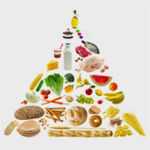
Foods can be divided into three groups; carbohydrates, meat and meat substitute and fat. Carbohydrate foods such as grains, fruits, vegetables and low fat milk are healthy foods. Hey provide energy needed for everyday activities. They also provide vitamins, minerals and fiber. It is important for people with diabetes to eat foods that have carbohydrate.
The balance between the amount of carbohydrate in food and insulin determines how much your blood glucose levels go up after meals. This means you need to know what foods have carbohydrates, what average serving size are, and hw many carbohydrates servings to eat.
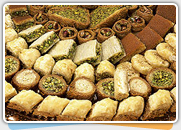
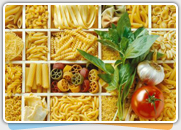
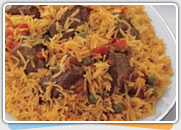




| Starch |
|---|
| Cereals, grains, pasta, bread, beans & starchy vegetables, One serving = 15 g carbohydrate |
| One carbohydrate serving is : |
| 1 slice bread, white, whole wheat |
| 1 waffle or pancake size of compact disc |
| 1 hot dog or hamburger bun |
| 3/4 cup unsweetened ready to eat cereal |
| 1 cup broth based soup |
| 1/2 cup cooked cereal |
| 4-7 whole wheat crackers |
| 1/3 cup cooked pasta |
| 1/3 cooked rice brown or white |
| 1/2 cup cooked beans, peas, corn, sweet potato, mashed or boiled potatoes |
| 1/4 large baked potatoe with skin |
| Non Starchy Vegetables |
|---|
| One serving= 5 g carbohydrate |
| One serving is free. If you can eat three or more servings count them as one carbohydrate serving |
| One serving of non starchy vegetable is |
| One cup raw vegetables such as tomatoes, zucchini, mushrooms |
| 1/2 cup cooked vegetables |
| 1/2 cup tomatoes or vegetable juice |
| Fruits |
|---|
| One serving= 15 g carbohydrate |
| One carbohydrate serving is: |
| 1 small fresh fruit |
| 1/2 cup unsweetened canned fruit |
| 1/4 cup dried fruit |
| 1/2 cup unsweetened fruit juice |
| 1 cup cantaloupe |
| 1 cup raspberries |
| 2 tbsp raisins |
| Meat & Meat Substitutes |
|---|
| Plan to eat 4-6 oz per day. Choose fish more often. Have meatless meal once or twice a week |
| 3 oz cooked chicken, turkey, fish, beef and lamb |
| 1 slice cheese |
| 1/4 cup fat free or low fat cottage cheese |
| 1/4 cup tuna canned in water |
| 1/2 cup tofu |
| 1 tbsp peanut butter |
| 1 egg |
| Milk |
|---|
| One serving= 12- 15 g carbohydrate |
| One carbohydrate serving is: |
| 1 cup fat free or reduced fat milk |
| 1 cup fat free or low fat plain soy milk |
| 1/3 cup fat free yogurt- plain or flavored & sweetened |
| Sweets & Dessert |
|---|
| One carbohydrate serving= 15 g carbohydrate |
| One carbohydrate serving is: |
| 2 inch square cake brownie unfrosted |
| 2 small cookies |
| 1/2 cup ice cream or frozen yogurt |
| 1/4 cup sorbet |
| 1 tbsp syrup, jam, jelly, table, sugar, honey |
| 2 tbsp light syrup |
| Other foods |
|---|
| These foods are combination foods. They have servings from several food groups |
| 1 cup casserole- 2 carbohydrate, 2 meat |
| 2 cup chow mein and 1 cup rice- 4 carbohydrates, 2 meat |
| 1 burrito with beef- 3 carbohydrate, 1 meat, 1 fat |
| 6 chicken nuggets- 1 carbohydrates, 2 meat, 1 fat |
| 1 cup cream soup mare with water- 1 carbohydrate made with water- 1 carbohydrate, 1 fat |
| 1/4 of 12 inch pizza cheese, thin crust- 2 carbohydrates, 2 meat |
| 1 small cup cake frosted- 2 carbohydrate 1 fat |
| 1 medium serving French fries fat food- 4 carbohydrate, 4 fat |
| Fat |
|---|
| One serving = 5 g fat Limit to three to five servings |
| One fat serving is: |
| 1 tsp margarine, butter, mayonnaise, oil |
| 1 tbsp cream cheese, salad dressing, reduced fat margarine or mayonnaise |
| 1 tbsp sesame, pumpkin or sunflower oil |
| 1 tbsp sour cream, half and half cream or salad dressing |
| 11/2 tbsp reduce fat cream cheese |
| Free Foods |
|---|
| These foods contain 0-5 grams of carbohydrates and less than 20 calories per serving. If a serving size is given limit to the food to three servings per day |
| 1 tbsp ketchup |
| 1 tbsp fat free cream cheese, mayonnaise, salad dressing |
| 1/4 cup salsa |
| Lemon Juice |
| Diet Soft Drinks |
| Prepared Mustard |
| Non fat cooking spray |
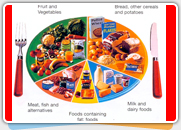
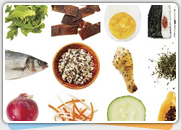
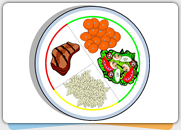
The plate method is a helpful tool to guide your food choices until you see a dietitian for your own meal plan. For e healthy meal.

Keep up on our always evolving product features and technology. Enter your e-mail and subscribe to our newsletter.